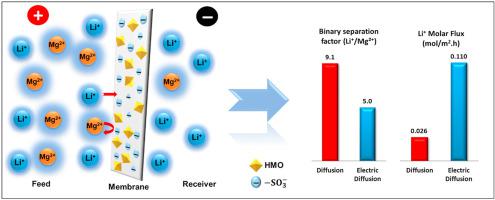当前位置:
X-MOL 学术
›
J. Membr. Sci.
›
论文详情
Our official English website, www.x-mol.net, welcomes your
feedback! (Note: you will need to create a separate account there.)
Development of highly selective composite polymeric membranes for Li+/Mg2+ separation
Journal of Membrane Science ( IF 8.4 ) Pub Date : 2021-02-01 , DOI: 10.1016/j.memsci.2020.118891 H.M. Saif , R.M. Huertas , S. Pawlowski , J.G. Crespo , S. Velizarov
Journal of Membrane Science ( IF 8.4 ) Pub Date : 2021-02-01 , DOI: 10.1016/j.memsci.2020.118891 H.M. Saif , R.M. Huertas , S. Pawlowski , J.G. Crespo , S. Velizarov

|
Abstract To meet the exponentially rising demand for lithium, it becomes vital to develop environmentally friendly processes for its recovery from brines, salt lakes and/or seawater. In this work, novel composite lithium transport selective polymeric membranes were developed to separate lithium and magnesium ions. Hydrogen manganese oxide (HMO) (at weight percentage from 0 to 25%), polystyrene sulfonate sodium salt (PSS–Na) and lithium triflate (LiCF3SO3) were added into the sulfonated polyethersulfone (SPES) matrix to prepare composite membranes. The developed membranes showed high mechanical stability and a homogeneous distribution of HMO. The most promising membrane, containing 20% (w/w) of HMO, showed an almost 13 times higher Li+ ionic conductivity (8.28 mS/cm) compared to the control composite membrane (without HMO) and an average ideal selectivity of 11.75 for the Li+/Mg2+ pair. The composite-20% membrane had the lowest intermolecular distance between the polymer chains (according to X-ray diffraction (XRD) analysis), the most flexible structure (lowest Tg) and showed the homogeneous dispersion of HMO (SEM images), which explains its highest Li+/Mg2+ selectivity among the tested membranes. The lithium ion transport performance and separation efficiency were investigated through diffusion dialysis experiments, under different operating conditions. A binary separation factor of 9.10 for Li+/Mg2+ and Li+ molar flux of 0.026 mol/(m2.h) was achieved without applying any external potential difference. When an external potential difference of 0.2 V was applied, the binary separation factor of Li+/Mg2+ pair was 5, while the Li+ molar flux increased almost 5 times. The obtained results provide the basis to design and develop composite lithium transport selective polymeric membranes, thus representing a promising step for future implementation of such membranes to recover lithium from saline streams.
中文翻译:

用于分离 Li+/Mg2+ 的高选择性复合聚合物膜的开发
摘要 为了满足对锂呈指数增长的需求,开发环保工艺从卤水、盐湖和/或海水中回收锂变得至关重要。在这项工作中,开发了新型复合锂传输选择性聚合物膜来分离锂和镁离子。将氧化氢锰 (HMO)(重量百分比为 0% 至 25%)、聚苯乙烯磺酸钠盐 (PSS-Na) 和三氟甲磺酸锂 (LiCF3SO3) 添加到磺化聚醚砜 (SPES) 基质中以制备复合膜。开发的膜显示出高机械稳定性和 HMO 的均匀分布。最有前途的膜含有 20% (w/w) 的 HMO,其 Li+ 离子电导率几乎高出 13 倍 (8. 28 mS/cm)与对照复合膜(不含 HMO)相比,Li+/Mg2+ 对的平均理想选择性为 11.75。20% 复合膜的聚合物链之间的分子间距离最低(根据 X 射线衍射 (XRD) 分析)、最灵活的结构(最低 Tg)并显示出 HMO 的均匀分散(SEM 图像),这解释了在所测试的膜中,它具有最高的 Li+/Mg2+ 选择性。在不同的操作条件下,通过扩散渗析实验研究了锂离子传输性能和分离效率。在不施加任何外部电位差的情况下,Li+/Mg2+ 和 Li+ 摩尔通量的二元分离系数为 9.10,为 0.026 mol/(m2.h)。当施加 0.2 V 的外部电位差时,Li+/Mg2+ 对的二元分离因子为 5,而 Li+ 摩尔通量增加了近 5 倍。所获得的结果为设计和开发复合锂传输选择性聚合物膜提供了基础,因此代表了未来实施此类膜以从盐水流中回收锂的有希望的一步。
更新日期:2021-02-01
中文翻译:

用于分离 Li+/Mg2+ 的高选择性复合聚合物膜的开发
摘要 为了满足对锂呈指数增长的需求,开发环保工艺从卤水、盐湖和/或海水中回收锂变得至关重要。在这项工作中,开发了新型复合锂传输选择性聚合物膜来分离锂和镁离子。将氧化氢锰 (HMO)(重量百分比为 0% 至 25%)、聚苯乙烯磺酸钠盐 (PSS-Na) 和三氟甲磺酸锂 (LiCF3SO3) 添加到磺化聚醚砜 (SPES) 基质中以制备复合膜。开发的膜显示出高机械稳定性和 HMO 的均匀分布。最有前途的膜含有 20% (w/w) 的 HMO,其 Li+ 离子电导率几乎高出 13 倍 (8. 28 mS/cm)与对照复合膜(不含 HMO)相比,Li+/Mg2+ 对的平均理想选择性为 11.75。20% 复合膜的聚合物链之间的分子间距离最低(根据 X 射线衍射 (XRD) 分析)、最灵活的结构(最低 Tg)并显示出 HMO 的均匀分散(SEM 图像),这解释了在所测试的膜中,它具有最高的 Li+/Mg2+ 选择性。在不同的操作条件下,通过扩散渗析实验研究了锂离子传输性能和分离效率。在不施加任何外部电位差的情况下,Li+/Mg2+ 和 Li+ 摩尔通量的二元分离系数为 9.10,为 0.026 mol/(m2.h)。当施加 0.2 V 的外部电位差时,Li+/Mg2+ 对的二元分离因子为 5,而 Li+ 摩尔通量增加了近 5 倍。所获得的结果为设计和开发复合锂传输选择性聚合物膜提供了基础,因此代表了未来实施此类膜以从盐水流中回收锂的有希望的一步。











































 京公网安备 11010802027423号
京公网安备 11010802027423号